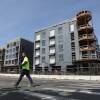Worcester is moving ahead with plans to mandate that a minimum percentage of new housing units within private development projects be affordable for low- and moderate-income households.
City councilors on Worcester’s economic development subcommittee on Tuesday said the requirement — known as inclusionary zoning — will help address a shortage of affordable housing around Worcester. The subcommittee directed the city manager’s office to begin drafting an inclusionary zoning ordinance that will be subject for review by City Council.
“This is personal for me,” Councilor Sean Rose said during the subcommittee hearing, noting that his family moved frequently during his childhood because they struggled to find affordable housing. “I often reflect back on what it would be like to actually be in the same place and not be the new kid every school year.”
Median rent in Worcester is currently $1,850, up $200 over this time last year. According to Massachusetts’ subsidized housing inventory, just 13.5% of Worcester’s housing stock is designated affordable for low- to moderate-income households. Massachusetts’ two other largest cities have a higher proportion of affordable housing: 21% in Boston and 16% in Springfield.
The affordable housing shortage has left about 50% of Worcester renters cost-burdened, meaning they’re paying over 30% of their income on rent and utilities.
Hundreds of housing units are currently under construction or being planned around Worcester. However, most of those units are market-rate, meaning developers can charge whatever they want for them — and the chosen rents may be too expensive for a lot of Worcester residents. City officials say inclusionary zoning is necessary to force developers to build more housing that’s affordable for lower-income residents.
“It’s not going to be the solution that addresses all the needs in the community, but it’s another tool that we can have,” Chief Development Officer Peter Dunn said at the economic development subcommittee hearing.
Dozens of Massachusetts communities already have some form of inclusionary zoning, including Boston, Cambridge and Quincy, though Springfield does not.
The Worcester City Council previously discussed inclusionary zoning during a meeting in May and unanimously voted to explore implementing it. But despite agreement on the need for more affordable housing in the city, there are specifics about the policy that need to be finalized before it can take effect.
In a report in May, Dunn said the city’s inclusionary zoning mandate should apply to all new complexes with at least 12 units. City officials will also have to determine income levels. They are considering requiring developers to ensure that 15% of the habitable square footage is for people who earn 80% of the area median income or 10% of the habitable square footage be available to people who earn 60% of the area median income.
Gina Plata-Nino, who chairs the Worcester Together Housing Coalition, favors the 60% area median income threshold. She said that would ensure that the inclusionary zoning ordinance sets aside apartments that are affordable for people making around the minimum wage.
“These folks are working-class individuals who are making sure our city stays afloat. They’re our frontline providers. They’re our child care workers,” Plata-Nino said. “But they can’t afford to live in the city.”
The inclusionary zoning proposal has received mixed reaction from developers working in Worcester. In a statement, Larry Curtis, president and managing partner of Boston-based WinnDevelopment, said the city deserves credit for pursuing inclusionary zoning.
“New residential multi-family development in Worcester should reflect the city’s vibrant, mixed-income demographics,” Curtis said. “Well-crafted inclusionary zoning laws are proven tools that give low and moderate-income households the opportunity to share in residential growth.”
But Carl Foley, president of Botany Bay Construction, pushed back against the effort, saying the city is attempting “to shift the affordable housing problem to the private housing industry.” Public agencies should do more themselves to address the housing shortage, he said.
The Home Builders and Remodelers Association, which represents developers in the city, added it doesn’t oppose inclusionary zoning but noted that building affordable units isn’t always as profitable for developers as building market-rate housing. If the ordinance is too strict, it could disincentivize future development in the city, said Joseph Landers, the group’s executive officer.
Dunn said he’ll try to make the inclusionary zoning ordinance flexible by loosening other zoning requirements for developers as well as allowing them to pay their way out of affordability minimums. The payments would go to Worcester’s new affordable housing trust fund, a pot of money that can be used to finance new affordable housing, rehab existing housing and assist low-income homebuyers.
“We want to make sure that when we look at this regulation in this way, it strikes the right balance,” he said.







